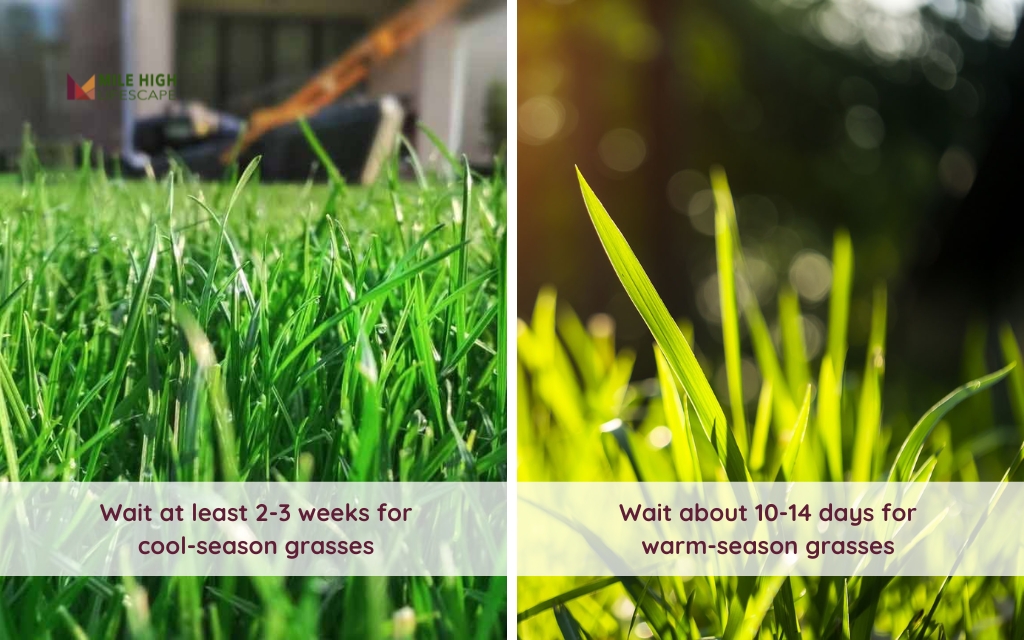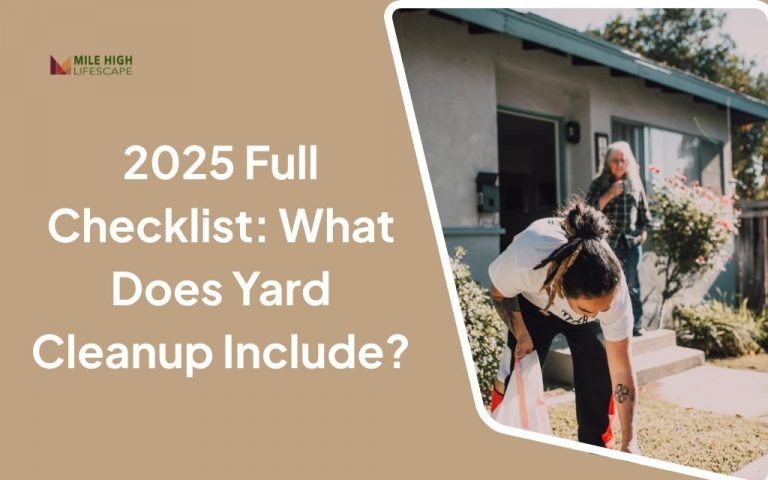Overseeding your lawn in Denver is an excellent method to enhance the density and overall health of your grass. However, it’s crucial to understand the appropriate waiting period before mowing after overseeding to avoid damaging the new seeds.
Normally, you should wait 2-4 weeks after overseeding before mowing your lawn to give the grass seeds enough time to germinate and form a healthy root system. It’s also a good idea to wait until the new grass reaches a height of about 3-4 inches, ensuring it is robust enough to withstand the mower.
Waiting Time to Mow After Overseeding (by Grass Type)
Different grass varieties require specific waiting periods after seeding. Below is a quick reference guide for common grass types in Denver lawns:
| Grass Type | Minimum Wait Time | Ideal First Mowing Height | Signs of Readiness |
| Kentucky Bluegrass | 3 weeks | 3 inches | Reaches 4+ inches, stands upright |
| Tall Fescue | 2 weeks | 3 inches | Reaches 4 inches, roots resist gentle pulling |
| Fine Fescue | 2-3 weeks | 2.5 inches | Reaches 3+ inches, uniform color |
| Bermuda | 10-14 days | 1.5 inches | Stands upright when walked upon |
Quick Reference Guide for Denver Lawns
Cool-Season Grasses
For common Colorado cool-season grasses like Kentucky Bluegrass and Fescue varieties, wait at least 2-3 weeks after overseeding before the first mow. These grasses need time to reach 3-4 inches in height and establish proper root systems. Kentucky Bluegrass particularly benefits from this waiting period, as it germinates more slowly than other varieties but builds exceptional drought tolerance when properly established.
For the first mow, set your cutting height to remove only the top ⅓ of growth. This maintains sufficient leaf surface for photosynthesis while encouraging lateral growth and thickness. Cool-season grasses thrive with a first-cut height between 2.5-3 inches, slightly higher than regular maintenance height.
Warm-Season Grasses
Though less common in Denver’s climate, warm-season grasses like Bermuda and Zoysia require a shorter 10-14 day waiting period after overseeding. Their more aggressive growth habit establishes faster, but still demands careful timing for the first mow. Wait until new blades stand upright when walked upon and reach approximately 2 inches in height.
The first mow for warm-season grasses should maintain a height of 1.5-2 inches to encourage lateral spread. Be particularly careful with mower turns on these varieties, as their spreading growth pattern makes them susceptible to scalping damage.

Signs Your Lawn Is Ready to Mow
Your lawn communicates readiness for the first post-overseeding mow through several indicators:
- Height achievement: New grass reaches or exceeds 3-4 inches consistently across the lawn
- Root development: Seedlings resist gentle tugging and remain anchored in soil
- Blade strength: Grass stands upright rather than laying flat when walked upon
- Uniform growth: Most seeded areas show similar development without significant bare patches
- Weather conditions: The forecast shows several dry days ahead without extreme temperatures
The “tug test” provides a reliable measure of root establishment—gently pull on a few grass blades in different areas. If they resist and remain anchored, roots have likely developed sufficiently for mowing.
How to Mow Your Lawn After Overseeding (Safely!)
The first mow after overseeding requires careful technique to protect your investment:
- Use a sharp mower blade: Dull blades tear grass rather than cut it cleanly, causing stress to new plants. Sharpen or replace your blade before this critical first cut.
- Adjust mowing height: Set your mower to remove no more than ⅓ of the grass height. For most cool-season grasses, this means a height setting of 2.5-3 inches.
- Ensure dry conditions: Mow when grass and soil remain dry to prevent ruts and clumping. Wait until afternoon dew evaporates completely.
- Move deliberately: Use slow, steady passes without sharp turns that could uproot seedlings. Consider mowing in straight lines with manual turns off the lawn when possible.
- Consider mulching clippings: Return finely-cut clippings to the lawn to provide nutrients and moisture retention unless clippings appear excessive or clumpy.
The first post-overseeding mow establishes the pattern for future growth. Take time to execute it properly, even if it means spending extra time on this maintenance session.
Check out the detailed guide on How to Mow a New Lawn from the experts at Mile High Lifescape.
Mistakes to Avoid When Mowing After Seeding
Even experienced lawn enthusiasts make these common errors when managing newly overseeded lawns:
- Mowing too soon after overseeding. This damages root development and creates bare patches where seedlings get pulled from the soil, resulting in thin, patchy growth that defeats the purpose of overseeding.
- Cutting grass too short during initial mowings. Short cutting heights force grass to prioritize top growth over root development and open space for weeds to establish. Maintain higher deck settings for at least the first three mowing sessions.
- Neglecting proper watering after the first mow. Many homeowners reduce watering frequency too dramatically after mowing begins. In Colorado’s arid climate, continue providing consistent moisture until new grass fully establishes (typically 4-6 weeks after germination).
- Applying herbicides too soon. Wait until after at least three mowing sessions before using any weed control products. Pre-emergent and post-emergent herbicides can damage or kill developing seedlings.
- Resuming heavy lawn traffic immediately. Continue limiting foot traffic, play activities, and pet access for several weeks after the first mow to allow root systems to strengthen.
- Using a dull mower blade. This tears grass instead of cutting it cleanly, creating stress and potentially pulling new seedlings from the soil entirely.
Conclusion
Remember that overseeding represents just one component of comprehensive lawn care. For optimal results, incorporate core aeration, proper fertilization, and appropriate weed control strategies throughout the year. These practices work together to create the resilient, vibrant lawn you desire.
For professional overseeding services, expert lawn care advice, or assistance with any aspect of your Colorado landscape, contact Mile High Lifescape. Our experienced team brings nearly two decades of local expertise to every project.
Frequently Asked Questions (FAQs)
Can I mow my lawn 1 week after overseeding?
No, mowing just one week after overseeding risks uprooting young seedlings before root establishment. For most Denver lawns with cool-season grasses, wait at least 2-3 weeks or until grass reaches 3-4 inches in height.
What happens if I mow too early after overseeding?
Mowing too soon after overseeding uproots young seedlings before they establish adequate root systems. This creates bare patches and uneven growth, potentially requiring you to repeat the overseeding process. Young grass plants need time to anchor themselves in the soil before withstanding the stress of mowing.
Should I water before or after mowing a newly overseeded lawn?
Neither. Mow only when the lawn is completely dry to prevent clumping and soil compaction. Resume normal watering 24 hours after mowing to allow cut grass blades to heal.
Should I bag clippings after the first mow?
Yes, bag clippings for the first two or three mowing sessions after overseeding. New seedlings need maximum sunlight exposure and can be smothered by heavy clipping coverage. Once new grass establishes more fully (after 3-4 mowing sessions), you can transition back to mulching to return nutrients to the soil.
How often should I mow after the first post-overseeding cut?
Begin with a mowing schedule of every 5-7 days depending on growth rate. Monitor grass height rather than following a strict calendar schedule. Remember to observe the one-third rule—never remove more than one-third of the total grass height in a single cut. As the season progresses, adjust your frequency based on growth rate and weather conditions.
Should I fertilize before or after the first mow?
Wait until after the first mow to apply fertilizer to newly overseeded areas. This timing allows grass plants to establish initial root systems that can effectively utilize nutrients. Choose a starter fertilizer with higher phosphorus content (the middle number in the N-P-K ratio) to encourage root development. Apply at half the recommended rate to prevent burning young grass.







